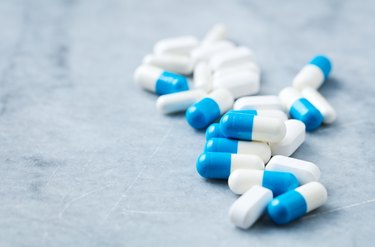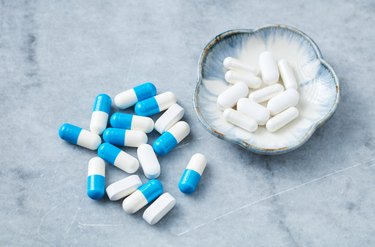
Creatine sources include the kidneys, liver and pancreas, though did you know that creatine could be obtained from your diet as well? Both meat and seafood supply creatine to the body and help maintain normal levels of the molecule, fundamental for proper body functioning.
Tip
Foods with creatine include red meat and seafood.
Video of the Day
What Is Creatine?
Creatine, according to the Cleveland Clinic, is a natural source of energy in the body that aids in muscle contractions. It's created in the kidneys, pancreas and liver and stored in the body's skeletal muscle, then metabolized during physical activity.
Video of the Day
The body continuously adds creatine in order to maintain normal, natural creatine levels. Once passed out from the body, into urine, creatine turns into creatinine. There are also small amounts of creatine used in the heart, brain and other tissues, though 95 percent is found in skeletal muscles.
According to MedlinePlus, adding creatine to your diet can be effective for improving athletic performance, improving muscle strength in both older and younger adults, aiding in recovery after intense exercise, diminishing the severity of injury and helping those who have syndromes that don't allow them to properly metabolize creatine.
There have been a profusion of studies on the effectiveness of creatine in helping treat other conditions, such as diabetes and fibromyalgia, though evidence is scant.
Natural Creatine Sources
Creatine is both produced in the body and obtained through one's diet. In fact, in order to keep up your normal levels of creatine, getting the molecule through your diet may be necessary. Huntington's Outreach Project For Education at Stanford (HOPES) states that creatine is created at a rate of about one gram per day in the liver, kidneys and pancreas.
As for creatine obtained through dietary means, people consume about one gram of creatine per day from foods with creatine, such as red meat or seafood. As you might imagine, vegetarians often have lower levels of creatine in their bodies and may need to turn to creatine supplementation.
It's been found that combining creatine sources with carbohydrates can increase muscle creatine levels as opposed to just creatine alone, explains MedlinePlus. Pairing five grams of creatine with about 93 grams of simple carbohydrates four times per day for five days was found to increase muscle creatine levels by 60 percent more than just creatine.
The Dangers of Creatine
According to HOPES, the dangers of creatine are few, as it's naturally produced in the body and consumed through diet. There have been a couple reports of renal dysfunction due to creatine supplementation, though most studies show there are no negative effects of creatine.
What's more, Cleveland Clinic points out a few other side effects to look out for. When creatine is combined with other supplementation or taken over a long period of time, complications in the kidney and liver may occur. You should also exercise caution about taking creatine supplements when dehydrated, as it may be dangerous.
Other reported side effects of long-term creatine supplement use include muscle cramps, seizures, dehydration, nausea, seizures and diarrhea. Creatine supplements may also cause weight gain as water may be retained in the body's muscles.
As the FDA does not regulate nutritional supplements, many potential side effects are unknown. In the event that you are thinking of taking creatine supplements, you should consider consulting your doctor first.


